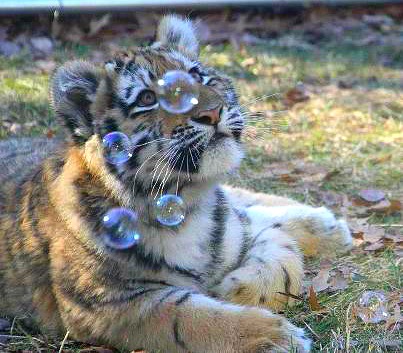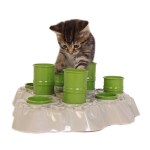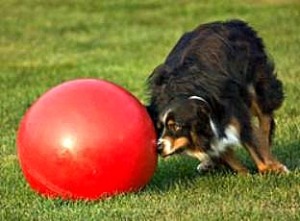Animal enrichment promotes naturalistic behaviors that stimulate the mind and increases physical activity. It reduces stress and therefore promotes overall health by increasing an animal’s perception of control over their environment and by occupying their time.

While working for a decade as an Enrichment Coordinator for various animal sections at the Audubon Zoo, I learned that physical and mental stimulation is vital to every species on the plant. Squid, poison dart frogs, mice, tortoises, spiders, jaguars, sheep, dogs, parrots, ferrets, anteaters, cats, and pigs all need daily mental and physical stimulation! Think of any animal, and I assure you that it needs daily stimulation.
Life is very stale and very boring without enrichment. Imagine sitting on the couch in your home. There are no windows. You cannot leave the house. No one ever visits you. You have no radio, T.V. iPhone, or internet. You have to eat and drink the same thing every day. What do you think would eventually happen to your mind and body after a day, then a week, then a month? This kind of mental stagnation is incredibly harmful to all living creatures. In fact, it’s downright deadly.
All animals need enrichment, which is a fairly simple but important concept. Enrichment improves or enhances the environment for an individual animal and stimulates the animal to investigate and interact with their surroundings more. At the Audubon Zoo, I would enrich an animal’s environment by making changes to structures in their enclosures, present novel objects and scents for them to investigate, change how we presented food to them, and much more.
We encouraged them to forage, hunt, and handle their food in ways that are natural to them in the wild. (The Shape of Enrichment has a great sample article of this kind of enrichment.) These tools were used on a regular basis at our zoo to alleviate boredom. Boredom often leads to frustration, and other unwanted behaviors. Giving animals more choices prevents boredom!

Coordinating Enrichment for Exotics
As an Enrichment Coordinator, it was my job to ensure that every animal in a particular section had species-appropriate enrichment provided for them every day. This could be anything from planting geographically appropriate plant species to encourage a critically endangered female Blue Iguana to forage on her native country’s plants to prepare her body for breeding season, to providing a Boomer Ball for our Miniature Donkey in the Children’s Zoo to keep her from becoming bored and harassing the goats, sheep, or visitors!
The video below is an excellent example of how we could use a Boomer Ball in a captive zoo environment. This demonstrates the fun and importance of mental and physical enrichment, with a focus on Choice, Change, and Complexity.
Behavioral enrichment should be random, interesting and novel. The goals of enrichment are to offer a sense of control by allowing animals to make choices and to stimulate species-appropriate behaviors
What Captive Otters Can Teach Us About Our Pets
Right about now you might be asking, “So what does an otter playing with a ball, underwater, at a zoo, have to do with my pet at home?” Well, that otter is a perfect example of what I encourage all of my clients to do with their pets, in their homes, every day: mentally and physically challenge them! Every one of you has the ability to have this much fun with your pets at home! I am going to explain how you can do this, why enrichment is so important for your pets, and how it improves your life as well.
How Enrichment Helps
Environmental enrichment, when used properly, can positively address many behavioral issues. This can be anything from “rowdiness,” cognitive dysfunction, storm and noise phobias, separation anxiety, obsessive-compulsive behaviors, and behaviors that result from the all too common problem in homes: boredom and/or frustration.
In addition to treating behavioral disorders, environmental enrichment should be viewed as an essential part of providing an excellent quality of life for all pets due to its proven positive effect on the health and well-being of animal companions.
What is Enrichment?
Enrichment can be defined as:
A process for improving or enhancing animal environments and care within the context of their inhabitants’ behavioral biology and natural history. It is a dynamic process in which changes to structures and husbandry practices are made with the goal of increasing behavioral choices available to animals and drawing out their species-appropriate behaviors and abilities, thus enhancing animal welfare . (Association of Zoos and Aquariums [AZA] Behavior Scientific Advisory Group 1999, excerpted from Disney’s Animal Programs).
Behavioral enrichment is defined as “the environmental enhancement of the lives of animals in a managed setting by providing them with mental and physical stimulation to increase natural and healthy behavior.”
Simply put, enrichment is “the act or process of increasing the intellectual or spiritual resources”.
More simply put: Add a little creativity, fun, and stimulation to an animal’s life!
Environmental enrichment for pets (also called behavioral enrichment) is a means to enhance a companion animal’s surroundings. It serves to enhance their life through means in which the animal is presented with novelty in his/her environment. The animal is given opportunities to learn. And the animal is encouraged to engage in natural, instinctive, species-specific behaviors.
Why Enrichment Is Important
Enrichment is as integral to animal care as veterinary and nutrition programs.
Behavioral enrichment and environmental enrichment are necessary components of life in captivity. Enrichment improves the welfare of all animals. All animals in captivity need environmental enrichment whether they live in a zoo, shelter, laboratory, sanctuary, or your home. It’s one of the 3 Key Elements That My Work Is Based Upon.
Studies have shown that when animals are given an enriched, stimulating environment (a variety of things to do, smell, and explore) they live longer, are better adjusted, more relaxed, better able to develop problem-solving skills, and they remember what they learn. This directly relates to your pets at home! Bored animals are easily frustrated, and frustration can lead to destruction. You can avoid boredom and destruction by enriching your pets! Enrichment is one of the keys to enhancing your pet’s life. It is also one of the easiest tools to implement on a daily basis.
Enrichment at Home Serves To:
- Curb boredom and restlessness of an animal
- Reduce frustration and destructive behaviors
- Increase an animal’s natural behaviors, and as result, increase their health and longevity
- Teach you new ways to engage and play with your animal companion
Types of Enrichment
Enrichment is generally grouped into the following categories. All of these can be used at home with your pets:
- Food based
- Sensory (touch, sight, smell, taste, and sound)
- Novel objects
- Social
- Positive Training
- Foraging

The Key to Successful (and appropriate!) Enrichment
As I mentioned earlier, enrichment is something that can, and should be, incorporated into your animal companion’s life every day. The image above is a great example of how easy it is to do! However, the key to successful (and appropriate) enrichment for an individual animal is doing a bit of research. Your homework is to understand your pet’s natural history. This means that you need to learn about the history of their species, or background and history of their breed.
For example, did you know?
- The Italian Greyhound was bred to hunt rabbits.
- The Dachshund was used to hunt badgers.
- The main reason cats were bred and kept around homes was originally for hunting vermin.
- The Bengal cat breed originally came from crossing domestic cats with wild Asian leopard cats.
- Although cats are carnivores, they still have an occasional craving for live green plants.
All of this matters!
The breeding history and the natural history of animals affects our pet’s today – even if only on a small level at times. Your domestic house cat still has a strong predatory instinct, so she needs to hunt every day. Your cockatoo may live in a metal enclosure in your house, but he/she still has the innate need to chew, fly, and forage. Your couch potato dog might have a lineage that was bred to swim and retrieve. We must provide opportunities for animals to do things that are in their DNA. We can provide simulated hunting, chewing, foraging, and seeking in our homes. This is what enrichment provides. It’s important that we take the time to put the pieces of their breed /species puzzle together.
Ask yourself:
- What would my _____ be doing if they were living in the wild??
- Are they nocturnal, crepuscular, or diurnal?
- Do they like to climb, hide, or fly?
- Do they enjoy chewing, foraging or digging?
- Do they need to soak or bask?
- Do they hunt, stalk, ambush, or chase?
- What does this breed of cat do really well, naturally?
- What does this breed of dog do on his/her own that might be a peek into their genes?
- What was this breed of dog, cat, horse, etc. originally bred for?
- What behaviors does this species do naturally in the wild?
- What kinds of food are found in their country of origin?
Exploring the breed- and species-specific background for each animal in your home is where we should begin thinking about how to provide appropriate enrichment for them.
The video below is an example of how hedgehogs naturally behave in the wild when they have the opportunity to make their own choices. Why does this matter? Well, if a hedgehog owner knows how hedgehogs naturally behave, then they can then provide this kind of stimulating environment for their hedgehog in the home! The same concept is true for your dog, cat, parrot, or turtle! When we learn about how our animals would behave naturally in the wild, we then have the tools to help them thrive and live long, healthy, happy lives with us in our homes!
Behavioral enrichment should be random, interesting and novel. The goals of enrichment are to offer a sense of control by allowing animals to make choices and to stimulate species-appropriate behaviors
How You Can Provide Enrichment at Home!
Most people have limited resources available to enrich the lives of their animal companions, which results in a huge lack of appropriate enrichment with most household pets, especially exotic animals. Making a few changes to their daily routines can greatly enhance the life and longevity of your animal companion! They key is to make things simple and safe, but challenging for the animal.
You don’t have to be rich to enrich your pet’s life!
One thing I learned very quickly while working at the zoo was that funds were limited. If you wanted to do a lot of enrichment, you had to get creative and do it yourself. This now carries over into our home, and also when I am working with a family that has a very limited budget. I teach my clients that anyone can make enrichment toys out of almost anything, and in the process you get to recycle in a super fun way!
Every night we give our dog Hocus Pocus (and the cats) some sort of enrichment challenge to do. Below is a video demonstrating a very easy one for her, but the point is to not just “give a dog a bone”. Make them work for it! Dogs are natural foragers, so allow your dog to utilize his/her natural instincts! Be as creative as you want to be! This kind of enrichment provides mental and physical stimulation, and in the process they learn that being alone is a Very Good Thing. Bonus: it gives you time to do whatever you need to get done while they are having fun!
Here’s another suggestion: The old school (“traditional”) method of feeding animals out of a bowl does little to stimulate complex feeding behaviors. Enrichment keeps animals active and interested, while encouraging natural behaviors! The video below is a great example of providing simple mental and physical enrichment for a very smart and energetic dog.
And here’s another easy example that we do with our dog, Hocus Pocus every night!
Below are a few more examples of simple, easy enrichment that we use in our home on a daily basis. Each of these are examples of natural behaviors that the animal would do in the wild if they were given choices. Click the links to see each short video:
- Offer Organic Wheat Grass for Cats. Many cats crave it!

- Keep your dog busy with food puzzles when repairmen have to come into your home. These redirect the dog’s energy onto something fun!

What Science Has Shown Us
Results from a study showed that when dogs solved a problem and earned a reward they wagged their tails more. These dogs were also more likely to try to solve the problem again, rather than if they were just given a reward. The study also found that food was a preferred reward, compared to spending time with another dog, or being petting by a familiar human.
Now let that really sink in for a moment …. What does that tell you?
In the video below, Chopin, the Moluccan cockatoo, is being challenged mentally and physically to utilize his natural foraging and problem solving skills to retrieve a high-value nut from a puzzle feeder. We used this kind of enrichment for Chopin to reduce aggression, frustration, and boredom.
I encourage everyone to learn what their animal enjoys doing. Discover their natural behaviors. Learn the history of the breed, and the natural history of the species. Once you understand these things, you can challenge the animal to move out of their stale comfort zone and step into the space of Who The Animal Really Is. Enrichment allows us to bring out the inner “House Panther” in a lazy cat. Enrichment transforms destructive dogs into mentally healthy canine companions. It changes frustrated parrots into relaxed, feathered friends.
Daily enrichment doesn’t have to be complicated and time-consuming, but the more creative you get, the more fun your animals will have! Make it a FUN challenge for you and them!
TIP: Be there with them as they discover their new toy. Encourage them every time they make a small success! Don’t just leave them alone with the new toy or puzzle feeder. You wouldn’t offer a puzzle to a child, then leave him/her alone in a room to “figure it out.” You would guide the child, and encourage the child when they make progress! The same is true for our animal companions. Encourage them. Praise them when they make small progress, and even when they are just trying to figure it out!
What kind of enrichment do you provide for your animals? Please share in the comments below!



Pingback: Things That Go BOOM In The Night | Conscious Companion
Nice article! I’m taking a course in feline training and enrichment is a huge part of “correcting” undesirable behaviors by redirecting energy towards activities that you can provide for cats in their own environment that are mentally stimulating. My five cats have benefited greatly from more enrichment in our home, and I’ve only been taking the course for about 2 weeks! Thanks for posting this thorough resource 😀
LikeLike
Thank you, Marci!! Way cool about taking a course on enrichment and training! Yes, I am a huge fan of redirecting undesirable behaviors into something FUN for the animal! We have to channel that energy somewhere, instead of merely saying, “NO!”. I am so happy to hear that you and your kitties are already benefiting from what you are learning. Rock on!
LikeLike
Oh – ps – you asked about what enrichment readers are using: right now, my cats are being entertained by a food puzzle; they have to manipulate a little wobbly egg to get treats out of it. They seem to like this a lot! Also, I’ve placed several cardboard cat scratchers around which they love to both lay on and scratch. They also have tons of little toys (crinkle balls, catnip mice, etc.) that I switch out weekly to keep them new and interesting, but their FAVORITE thing is to play with a little mouse on a wire attached to a wand. This lets them go through the whole prey sequence until they are tuckered out!
LikeLike
I love all of those options for them! The puzzle feeders are so great for encouraging them to be mentally and physically active. It really helps to tap into their natural predatory and hunting skills. Well done on the cat scratchers, switching the toys out to keep them novel, and especially using the “live prey” wand! It sounds like your kitties are very happy 🙂
LikeLike
Pingback: A Life Less Complicated | Conscious Companion
Pingback: Was It Out of Spite? Think Again. | Conscious Companion
Pingback: Halloween Without Havoc! | Conscious Companion
Pingback: Easter Egg Hunting Has Gone to The Dogs!!! | Conscious Companion
Pingback: Be Kind To Animals E V E R Y Week | Conscious Companion
Pingback: Foraging Felines! | Conscious Companion
Pingback: Disco, Cats, and Canines! – Conscious Companion
Pingback: Wheels of Light Keep Turning! – Conscious Companion
Pingback: Thanksgiving Tips for Busy Families (plus silly bloopers) – Conscious Companion